Guitar Maintenance
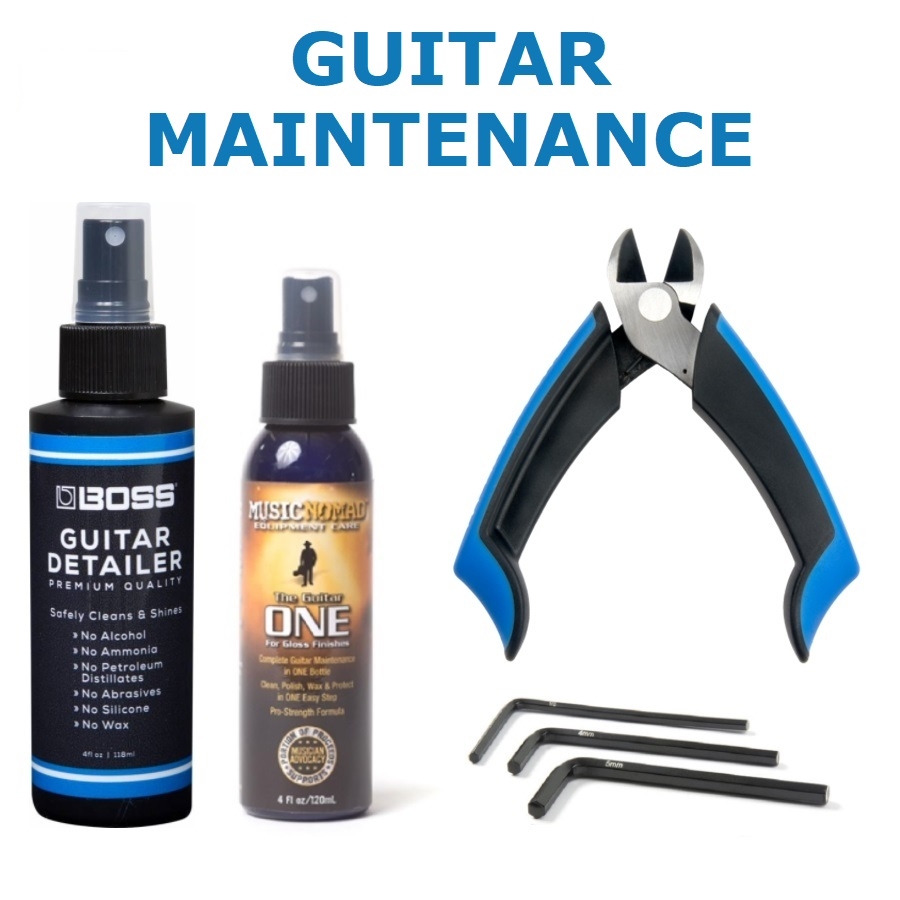
Guitar maintenance is very important, because guitars are made of wood. Wood is a natural and porous material, which means it changes over the years. Wood responds to moisture, temperature, and sunlight. This could potentially lead to dehydration, tears, and even bending. This could all be kept to a minimum or even prevented with proper maintenance. A nicely cared for guitar will also continue to hold its quality for a lot longer because the maintenance will preserve the tone, prevent serious problems, and ensures proper tuning stability. There are multiple forms of maintenance, but cleaning and conditioning are the most important. However, we will also explain less common maintenance tips in this article, because for some guitars these steps are also necessary. Additionally, we will also describe the different types of maintenance products so that it is hopefully easier for you to decide which products are right for you.
Check out our selection of maintenance products!
How do you know if your guitar requires care?
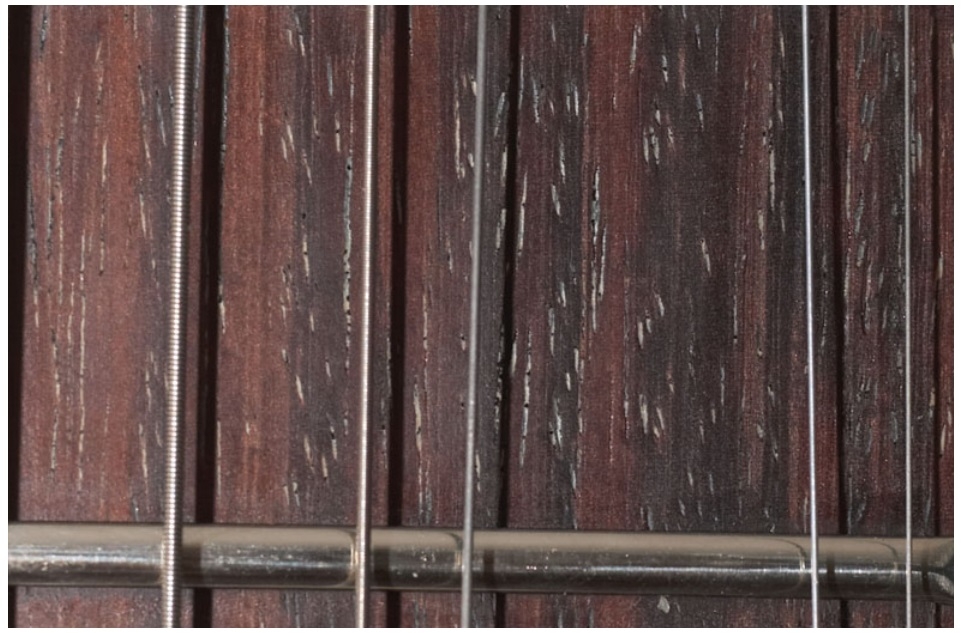
There are certain rules which might help you decide whether your guitar needs maintenance. The most important rule determines how often you need to change your strings. Most people say strings need to be changed about every six months, but it’s a contentious debate. Usually it’s somewhere between three to nine months. This article will not go into string changing, but this rule does rely on it. When you change your strings, it is also advisable to completely clean and condition your guitar. There are also signs on your guitar which distinguish whether you need to take care of your guitar, if you don’t want to rely on rules. Firstly, signs which show dehydration of the fretboard, because that’s usually the main aspect of maintenance. One way of finding out whether your fretboard needs conditioning, is by feeling your fretboard. If it feels a little dry or rough, it’s likely dehydrated. Another sign is tears in the wood. These can be quite small, but also rather big. This is a relatively important sign and requires conditioning as soon as possible. For example, the fretboard in the picture is severly dehydrated and has tears. It's advisable to not let it get this bad, but this is still saveable. Other signs of maintenance can be accumulation of dirt on the fretboard, neck, or body. Lastly, the intonation and the action are also signs of deterioration. These maintenance techniques are a little more complicated, but it is definitely possible and we will explain these as well.
Cleaning
.jpg)
Cleaning is a regular requirement, because guitars get dirty rather quickly. This is because guitarplaying is actually quite intensive. You touch the guitar with both hands, which means sweat, oil, dead skin cells, and any other dirt that you might have on your hands will end up on the guitar. As stated before, the wood will over time react to this. It is thus important to keep it clean. This is not hard, actually. Firstly, it is advisable to regularly wipe your guitar with a microfiber cloth. This is a really simple and quick way to keep most dirt and dust off your guitar. There are no rules for this, because it is absolutely not harmful at all. However, there are so more intensive cleaning methods which shouldn’t be used that often, only when its necessary. These cleaning products can be found in music stores and shouldn’t be bought anywhere else. This is because these products are specifically made for guitars, which should not harm the guitar while simultaneously cleaning it properly. There are different products for different types of guitars, as well. Solid body guitars need a products which cleans the lacquer without harming it, and is not reliable to tone stability, whereas acoustic guitars might not be finished and should be cleaned in a different way. Even if the body is finished on the outside, the inside will likely not be finished. For solid body guitars the kind of lacquer is also important. Guitars that are finished with a matt finish or a nitrocellulose finish shouldn’t be cleaned with polish, either. This is because the polish will go through the lacquer instead of cleaning it. These types of finishes solely need to be cleaned with a microfiber cloth. Nevertheless, most guitars have a polyurethane finish, which often requires polishing. There are multiple types of cleaning products, but all of them have to be applied with a microfiber cloth, often in circular motions. Acoustic guitars should only be polished when absolutely necessary, because the open wood might absorb the polish, even if it didn’t need it. Popular cleaning products include The Guitar One by Music Nomad, the Dunlop 654, and the Boss BGD-01.
Fretboard Conditioning
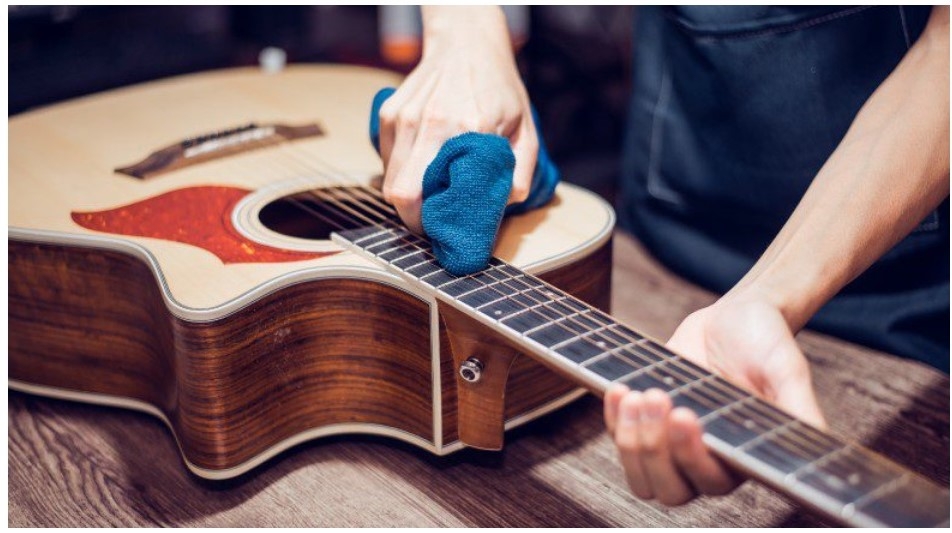
Fretboard conditioning is the most important aspect of guitar maintenance. This is because the fretboard is the most used part of the guitar, it also determines the comfortability of playing, and it’s usually made of unfinished wood. Dirt accumulates quite quickly and the wood reacts to this, which could possibly lead to dehydration, tears, shrinkage, and bending. This needs to be taken care of and prevented. This is actually quite simple and only has two steps, which sometimes can be combined. The first step is cleaning. It is advisable to clean the fretboard with a slightly damp microfiber cloth. You can definitely put some pressure on this, especially if you haven’t cleaned it in a while. Most dirt will come off with this step. There are cleaning products specifically for fretboards, but those are only necessary for really dirty fretboards. These are products like the GHS Fast Fret or the Dunlop 6502. The second step is conditioning. Before you purchase any products, it is important to know which wood your fretboard is made out of. Woods like ebony, rosewood, pau ferro, and laurel tend to not be finished and need to be conditioned regularly. Pau ferro and laurel are slightly drier than ebony and rosewood, so they might have to be conditioned a little more often. Maple is the outlier, because it is almost always finished. Finished woods do not need to be conditioned, because it’s not open wood anymore. How do you know if your wood is finished? It’s actually quite easy. If your fretboard is shiny and slick, it’s likely finished. If it looks and feels more matt, it’s likely unfinished. In this case, conditioning is really important. Depending on the climate you live in, you’ll likely need to condition every six months. If it 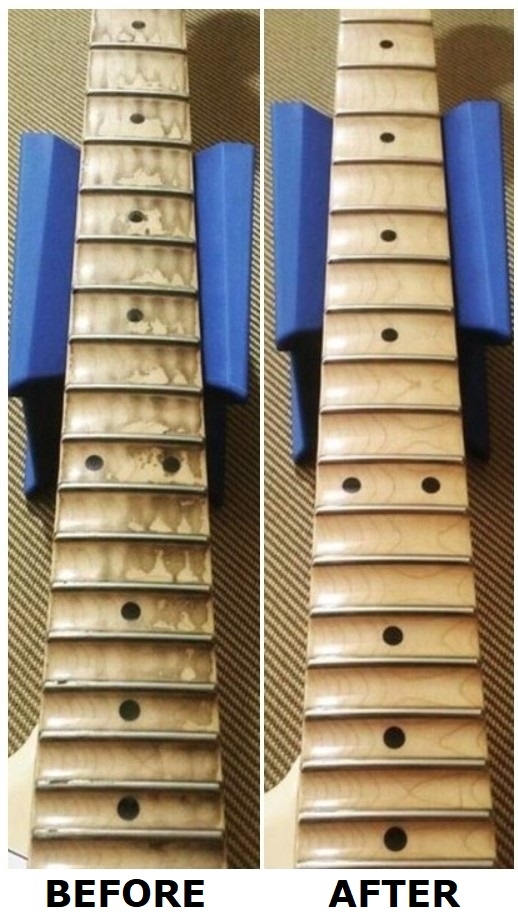 feels really dehydrated, more often is also possible. If it feels properly conditioned, less often is also good. However, try not to condition too often, overhydrated fretboards tend to expand, which is damaging as well. Which product is best for conditioning? In the community it is often called lemon oil. However, please be aware that this is simply the name of the product, and it’s not actually lemon oil. Please do not apply actual lemon oil to your fretboard because it’s way too acidic. Fretboard oil, which is only called ‘lemon oil’, is made out of minerals and only has a lemon-like scent. The minerals hydrate your fretboard and the scent only covers up the possible bad smells. There are many different conditioning products, but the most popular are the Goby Labs GLC104, the Dunlop 6554, and the Music Nomad F-One. With these types of products it’s also not necessary to completely clean the fretboard. The conditioner takes off the left-over dirt while hydrating the fretboard. It is advisable to clean the worst dirt off prior to conditioning, anyway, but a deep cleaning isn’t always necessary. In the picture on the side you’ll see a very dirty fretboard which was only treated with fretboard conditioner. Light cleaning beforehand will save you some conditioner, however. Additionally, this fretboard is very dirty, and it’s not advisable to let it get this bad. Keep regularly conditioning your fretboard for a healthy guitar. Conditioning itself is quite easy, fortunately. Apply the conditioner on a microfiber cloth and rub it in circular motions into the fretboard. You'll likely notice that after a few frets you'll have to rewet the cloth. When you're done, let it sink in for a while. If there is still a little left after letting it sit, you can just wipe it off. That's it, your fretboard is conditioned. You'll notice that the wood is slightly darker after conditioning it, but this will go back to normal after you've played a few times.
feels really dehydrated, more often is also possible. If it feels properly conditioned, less often is also good. However, try not to condition too often, overhydrated fretboards tend to expand, which is damaging as well. Which product is best for conditioning? In the community it is often called lemon oil. However, please be aware that this is simply the name of the product, and it’s not actually lemon oil. Please do not apply actual lemon oil to your fretboard because it’s way too acidic. Fretboard oil, which is only called ‘lemon oil’, is made out of minerals and only has a lemon-like scent. The minerals hydrate your fretboard and the scent only covers up the possible bad smells. There are many different conditioning products, but the most popular are the Goby Labs GLC104, the Dunlop 6554, and the Music Nomad F-One. With these types of products it’s also not necessary to completely clean the fretboard. The conditioner takes off the left-over dirt while hydrating the fretboard. It is advisable to clean the worst dirt off prior to conditioning, anyway, but a deep cleaning isn’t always necessary. In the picture on the side you’ll see a very dirty fretboard which was only treated with fretboard conditioner. Light cleaning beforehand will save you some conditioner, however. Additionally, this fretboard is very dirty, and it’s not advisable to let it get this bad. Keep regularly conditioning your fretboard for a healthy guitar. Conditioning itself is quite easy, fortunately. Apply the conditioner on a microfiber cloth and rub it in circular motions into the fretboard. You'll likely notice that after a few frets you'll have to rewet the cloth. When you're done, let it sink in for a while. If there is still a little left after letting it sit, you can just wipe it off. That's it, your fretboard is conditioned. You'll notice that the wood is slightly darker after conditioning it, but this will go back to normal after you've played a few times.
String Maintenance
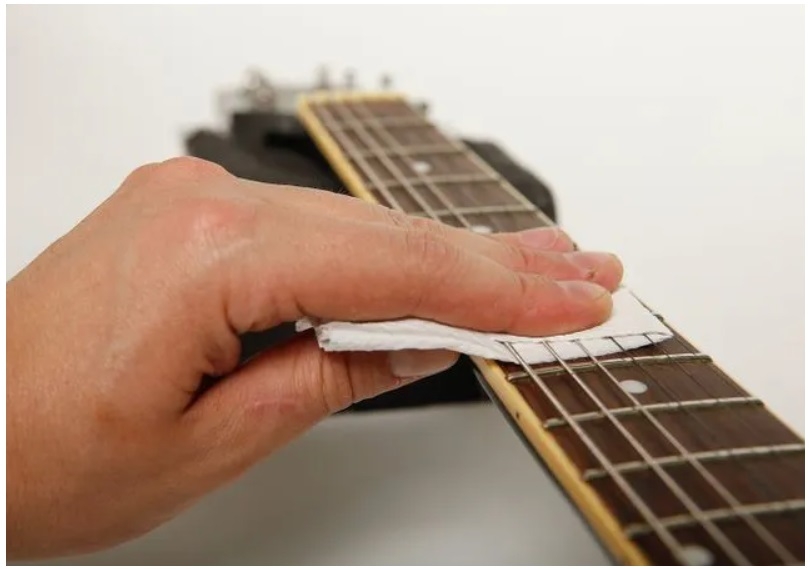
Maintenance for your strings is not essential, but can be quite handy. Strings deteriorate the more you play. They have to be changed regularly, about once every six months. More enthusiastic players will probably have to change them even more often. However, there are methods which prolong the lifespan of your strings. The deterioration of strings is mostly caused by your skin. Your fingertips carry natural oils, sweat, dead skin cells, and maybe some other dirt as well. Consequently, when you touch a string, these particles will then get on the strings. This will eventually corrode the strings. This is partly due to the fact that some of these particles are acidic, and that strings tend to be made of nickel or bronze. When the string corrodes, it becomes rough, the sound will be less clear, and the string might even break. One simple way to prolong this process is by washing your hands before playing. Most of the dirt will be stripped from your fingers, which means there will be less particles on the strings. This doesn’t completely prevent it, though. During the playing of your instrument you’ll likely sweat and create more dead skin cells with the pressure of the strings on your fingers. You’ll find that your strings may last slightly longer, but not significantly longer. There are also certain products which might be helpful. There are a range of products which are inherently trying to do the same thing. This can be in the form of cleaning products, like the Goby Labs String Wipes. These environmentally friendly wipes can be used to wipe the strings. They will remove dirty and acids from your strings, preventing (further) corrosion and making your strings sound more clear. These wipes are a good product for 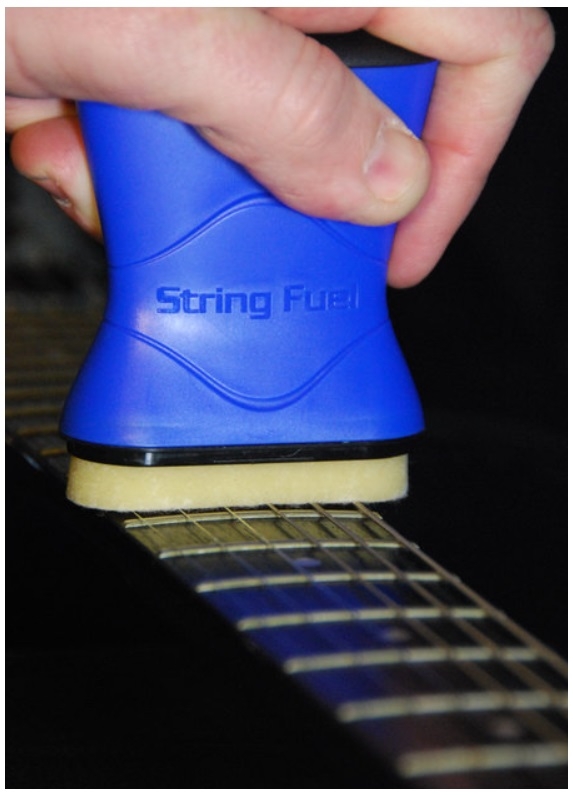 prolonging the lifespan of your strings, but only if you use them regularly, like once a month or biweekly. Another reliable cleaning product is the GHS Fast Fret. It doesn’t only clean your strings, but also your fretboard. It’s a two birds, one stone situation. The Fast Fret cleans your strings, restores the sound, and prevents corrosion. Simultaneously, it also cleans the dirt and acids off your fretboard. This is handy, because the products thus makes sure the strings don’t further corrode from the dirt on your fretboard. Lastly, there are also products on an oil-basis, like the Dunlop String Cleaner & Conditioner. This product cleans your strings and conditions them, at the same time. They thus prevent corrosion and protect them. The Music Nomad String Fuel is quite similar, but it is a more butter-like consistency instead of liquid, and it has an applicator. All these products are recommendable and the differences between them are minimal. The differences are mostly about the consistency and how they have to be applied, it depends on what method you prefer. It is important to realise that these products prolong the lifespan of the strings, but they do not prevent deterioration completely. Eventually, you’ll have to change your strings. However, if your strings usually last about five months, but now they might last about eight months. There is a sort of last method which you can try. This doesn’t prevent corrosion, but it might prevent it getting worse quickly. When your strings are already corroding, you can fold high grain sandpaper and run it along the strings. The grain is fine enough that it doesn’t harm the strings, but rough enough that part of the corrosion will sand off. The strings will feel and sound better. The lifespan will be prolonged slightly, although if your strings already are corroding, it can’t completely be removed.
prolonging the lifespan of your strings, but only if you use them regularly, like once a month or biweekly. Another reliable cleaning product is the GHS Fast Fret. It doesn’t only clean your strings, but also your fretboard. It’s a two birds, one stone situation. The Fast Fret cleans your strings, restores the sound, and prevents corrosion. Simultaneously, it also cleans the dirt and acids off your fretboard. This is handy, because the products thus makes sure the strings don’t further corrode from the dirt on your fretboard. Lastly, there are also products on an oil-basis, like the Dunlop String Cleaner & Conditioner. This product cleans your strings and conditions them, at the same time. They thus prevent corrosion and protect them. The Music Nomad String Fuel is quite similar, but it is a more butter-like consistency instead of liquid, and it has an applicator. All these products are recommendable and the differences between them are minimal. The differences are mostly about the consistency and how they have to be applied, it depends on what method you prefer. It is important to realise that these products prolong the lifespan of the strings, but they do not prevent deterioration completely. Eventually, you’ll have to change your strings. However, if your strings usually last about five months, but now they might last about eight months. There is a sort of last method which you can try. This doesn’t prevent corrosion, but it might prevent it getting worse quickly. When your strings are already corroding, you can fold high grain sandpaper and run it along the strings. The grain is fine enough that it doesn’t harm the strings, but rough enough that part of the corrosion will sand off. The strings will feel and sound better. The lifespan will be prolonged slightly, although if your strings already are corroding, it can’t completely be removed.
Adjusting the Action
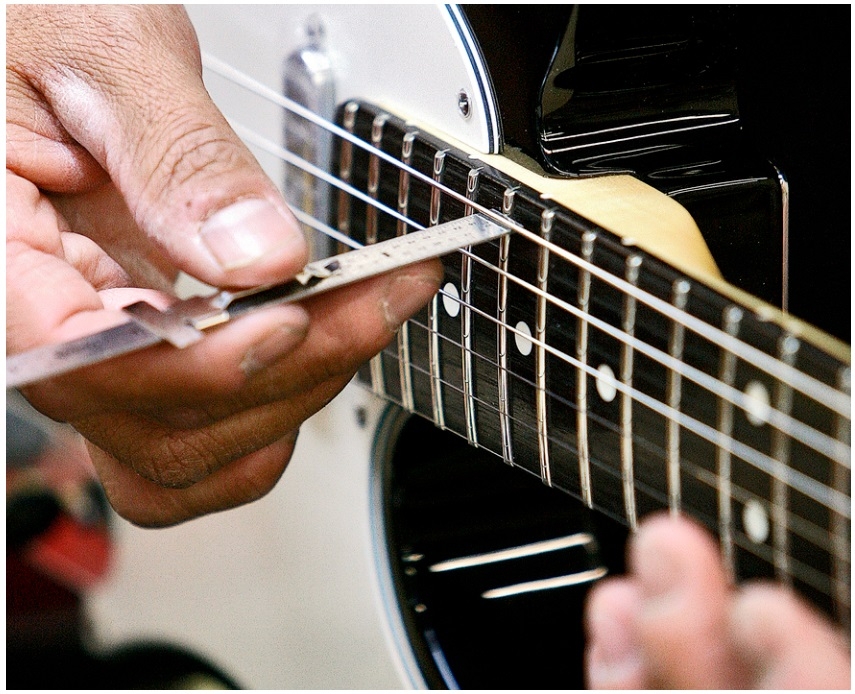
This is a more technical aspect of guitar maintenance. Fortunately, this is also not something you have to do regularly, only when it’s necessary. The action is the distance between the string and the fretboard. The strings are stretched between the nut and the bridge. If one of the two sits too high or too low, the action is off. If the action is too low, it can result in string-buzz. String-buzz is a buzz-like sound which happens when the string hits other fret ends when it’s vibrating. It means that the string cannot clearly vibrate and resonate. If the action is too high, it can make playing a lot harder. If the strings are too far away from the fretboard, it means you have to push them down further and harder to create a proper sound. This can be quite uncomfortable and will likely create an unstable intonation. Intonation will be discussed in the next paragraph. How do you decide if your action is right? Firstly, if it’s slightly uncomfortable to play the strings, especially higher up the neck, your action is likely too high. If you experience string-buzz, your action is likely too low. You can also measure your action with a ruler. Usually, the action has to be somewhere between 1.5 and 2.5 millimetre. The height also differs per string. The thicker strings tend to have a slightly higher action than the thinner strings. The last method of checking the action is by putting a finger on the first fret, and one on the last. If u then look in between the string and the fretboard, you can see if the string hits other fret ends. If this is the case, your action is too low. If you have established how your action is off, you can adjust it. If the action of the bridge is off, it’s actually quite simple to fix. Firstly, you have to take the tension off the strings, so these won’t be pulled even tighter. Most bridges have individual saddles, which can be adjusted with an hex key (also known as an Allen wrench) or with a screwdriver. There are usually two adjustment points per string, one for the action and one for the intonation. The action has to be adjusted with the height of the strings, whereas the intonation is about the distance of the strings. You thus need to adjust the right point. The adjustment point for the action is usually vertical on the bridge. With the hex key or the screwdriver you can quite easily adjust the action this way. These tools can be found at Joh.deHeer, as well! Like the Ernie Ball Toolkit, the Music Nomad Truss Rod Set, or their Octopus. Some guitars don’t have an adjustment point like this, but a little wheel instead. By turning the wheel the action is adjusted. If the action on your bridge is fine, it might be your nut, instead. This is significantly more complicated. If your action is too low, you’ll likely need an entirely new nut, because there is no way you can make the notches shallower. If your action is too high, it is usually a little easier. You can either sand the notches deeper, or remove the nut and sand some of the bottom. The latter is only possible if your nut isn’t glued in, because then it’ll likely break if you try to pry it out. There are thus options to fix your nut, but it is advisable to get this aspect fixed by a luthier, instead.
Adjusting the Intonation
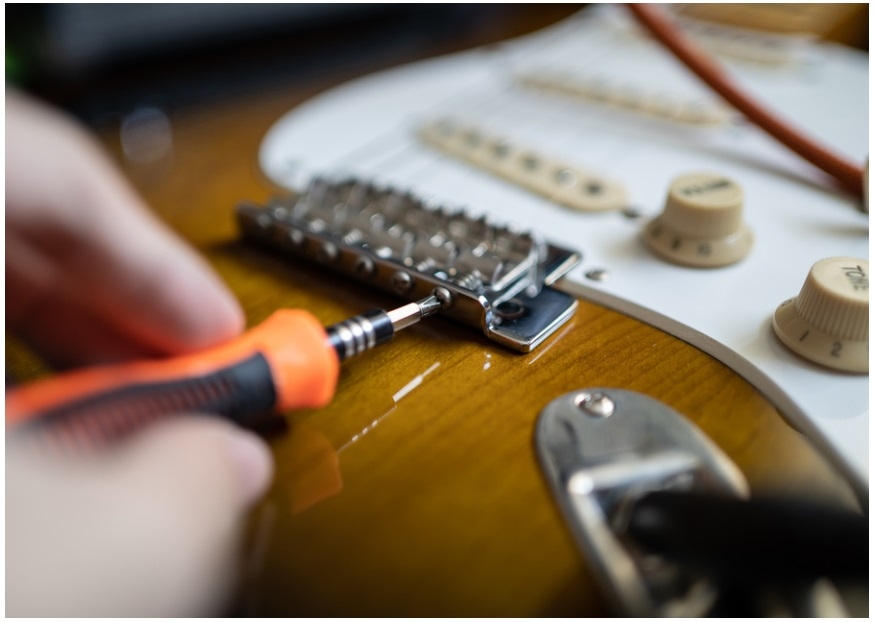
This is also a more complicated part of maintenance which is also only adjusted when strictly necessary. The intonation is how the tuning is divided over the length of the strings. Strings are spun over the fretboard. If you tune the string to the right tuning, it means the first fret has the right tuning. This doesn’t automatically mean the other frets are also tuned correctly. Especially higher on the neck it might differ quite significantly. However, this can be fixed. First, it is important to see if the intonation is right. This is quite easy. Put a tuner on your guitar, and play the open string. Then, put your finger on the twelfth fret. If the tuning is the exact same as the open string, your intonation is correct. It might be easier to play the twelfth fret harmonically, but that’s not necessary. The twelfth fret is important, because it’s an entire octave higher than the open string. If the twelfth fret is slightly differently tuned than the open string, it means your intonation is off. The second step is establishing whether your tuning is flat or sharp. If your tuning is flat, thus lower than the open string, you need to shorten the length. If your tuning is sharp, thus too high, the string needs to be lengthened. Both are equally as simple. Take the tension off the strings. Next, locate the adjustment point on the bridge. It’s usually somewhere behind the saddles. They’re usually adjustable with a hex key or a screwdriver. Adjust the saddle in the right direction. Forward if you want to shorten the string, and backwards if you want to lengthen it. It is advisable to only adjust it slightly every time. Tune the strings back up, and check the intonation again. It is very possible that the intonation still isn’t completely right. This is the downside of fixing the intonation, because it is actually quite simple but also quite repetitive. Repeat the steps until the intonation is right.
Adjusting the Truss Rod
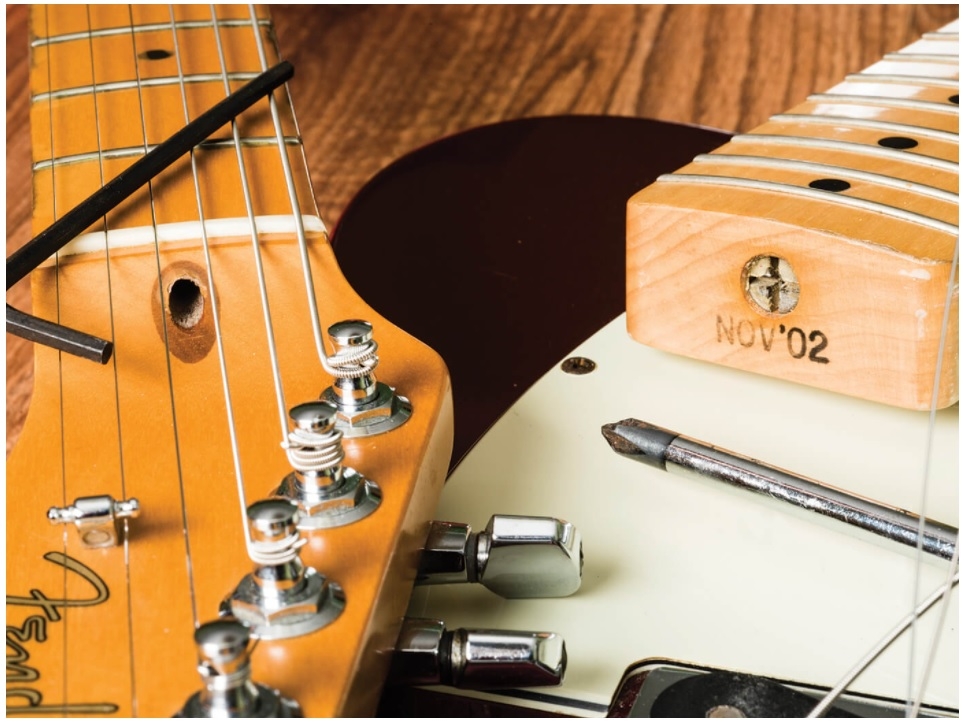
One of the most important prerequisites for playing guitar properly and comfortably is a straight neck. A slightly bowed neck can already cause significant problems. It can be uncomfortable, it can sound off, it can ruin the intonation and the action, and can lead to string-buzz. If your intonation or action cannot be fixed with the previous two methods, it is likely the neck that’s off instead. Fortunately, it’s quite easy to fix. Nowadays, most guitars have a truss rod installed inside the neck. This is a long metal rod which keeps the neck straight. It can also adjust it, if necessary. Usually, there is a little hole at the top of the neck, at the base of the headstock. Sometimes the hole is open, sometimes it is covered with a truss rod cover. The latter simply means you have to take out the little screws. The truss rod can then be adjusted with a hex key or a screwdriver. Some guitars do not have the adjustment point at the top, but at the bottom instead. This can be relatively annoying, because with some guitars it means you have to take the entire neck off. Sometimes you can already reach the truss rod by taking off the pickguard. Again, it is usually adjustable with a hex key or a screwdriver. Some guitars have innovative little wheels at the base of the neck, instead. This makes truss rod adjustment very easy. When adjusting the truss rod, you always have to take the tension off the strings first. Then, you have to adjust it in the right direction. If you want to adjust it forwards, you have to turn it counter clockwise. If you want to adjust the neck backwards, you need to turn it clockwise. Be aware that adjusting the truss rod can actually lead to damage or even a broken neck. This is quite rare, but if you turn it too hard or too much, it is possible. It is advisable to only turn it no more than a quarter, and if it’s still off, wait a day and adjust it more. The wood will have enough time to get used to its new position, and you can push it slightly further again. If this scares you, or if your truss rod requires you to take off the neck, you can of course always ask a luthier for help.
Moisture (Climate Control)
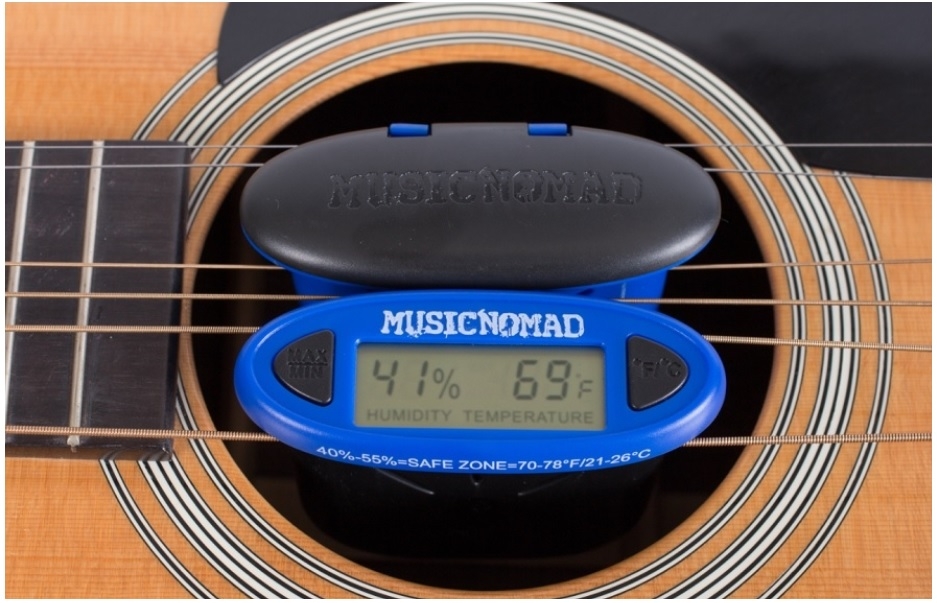
To reiterate, guitars are made of wood, which means moisture can be quite dangerous. However, dehydration is actually just as damaging. This means, for example, that you have to condition your fretboard. But also the body of your guitar requires similar care. The inside of acoustic guitars is often not finished. This isn’t laziness or stinginess, but it’s a tone quality matter. Unfinished wood resonates way better than finished wood, which is why the inside is often left unfinished. The downside is that the inside can be affected by moisture or dehydration. The best way to maintain this wood is by regulating the moisture. This means there are specific methods and products for taking care of your body. What you need for maintaining your wood, depends on your situation. Some climates and houses/rooms are very humid, whereas others might be quite dry. You can use a regular humidifier, but it is best to use a specific guitar humidifier for this. There are specific case humidifiers, or sound hole humidifiers, both for guitars or for ukuleles. These sound hole humidifiers only regulate the humidity in and around the guitar, which means you can specifically regulate it for the needs of your guitars. How do you use these humidifiers? The consensus is that guitars are best stored with a humidity level of 40-50% and a temperature of 20-23°C. Make sure your guitar is regulated somewhere between these levels. If this seems complicated, there are humidifiers with a humidity sensor, which regulates it according to these rules by itself.
How to treat your guitar better
.jpg)
This is technically not about maintenance, but about preventing maintenance. The previous paragraphs have established that the quality of the material deteriorates mostly due to moisture, temperature, sweat, and natural oils. Consequently, if you avoid contact with these things, the deterioration of certain materials can be postponed. For example, by washing your hands before playing or picking up your guitar, you get rid of most dirt and acids. Some guitarists even refuse to play their guitar if they’re wearing short sleeves. By wearing long sleeves, their bare arm will not rest on the body, which means that the natural acids of the skin will not deteriorate the lacquer. There are also people who solely store their guitars in a case. By keeping it in a case, the guitar will be less affected by humidity and temperature, because there is a protective layer between the guitar and the environment. However, these habits are not actually recommendable. A guitar is an instrument, a piece of equipment, even. This means it is supposed to be used and to be enjoyed. Only using your guitar under certain circumstances can actually decrease the enjoyment, creativity, and passion a player might have. Of course it is advisable to be relatively careful with your instrument, but a little damage is inevitable. A guitar is made to be used, it will collect scratches on the body, dirt on the fingerboard, and strings will always have to be changed. Being incredibly careful with your guitar will prolong the process, but it will not prevent it. The best way to treat your guitar is by using it regularly and maintaining it properly. This way, your guitar will likely last your decades and you’ll get the most out of it.
To Conclude
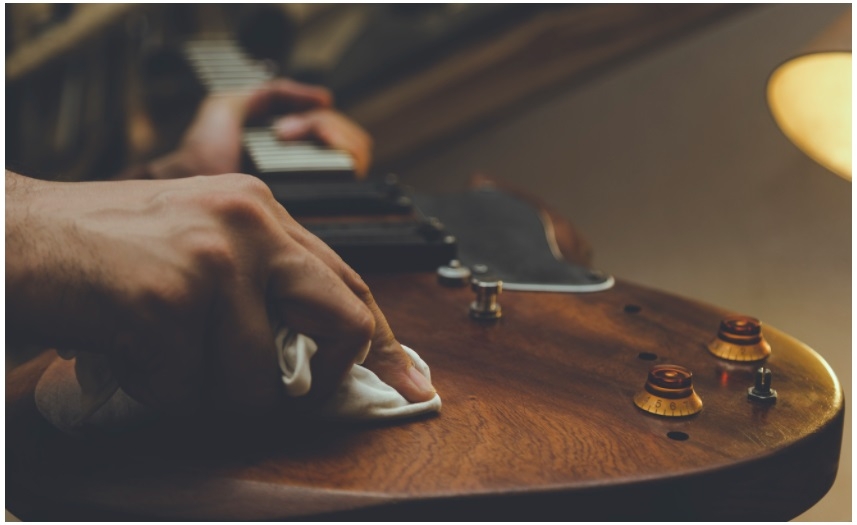
Thus, there are two main different types of maintenance: regular maintenance and sporadic maintenance. Regular maintenance needs to be applied regularly, like once a year or twice a year, whereas sporadic maintenance is only applied when absolutely necessary. Regular maintenance includes cleaning, conditioning, humidifying, and string changes. Sporadic maintenance includes adjusting the action, the intonation, and the truss rod. All these maintenance aspects can be done at home, if you want. All methods are explained in this article. However, it is also possible to have certain things done by a luthier. Most of all, we hope this article convinced you of the importance of guitar maintenance and inspired you to take care of your guitar(s). If you still have questions, you can always get into contact or come by our store where we will happily help you. Our guitar tech can even help you with certain tasks.
Check out our selection of maintenance products!
assortment
Music Nomad Acoustic Guitar Humidifier
The Acoustic guitar soundhole humidifier is very useful, because acoustic guitar wood needs moisture to play and look good. A dry guitar can warp, shrink or crack. Music Nomad has developed an easy-to-use and low-maintenance guitar humidifier. The Humitar safely releases moisture evenly to eliminate these potential problems. The innovative Humid-i-Bar holds a lot of water. This means less control while ensuring your guitar is taken care of. Time to check the Humitar? Calm down! Pop the top, touch the insert; if it's wet, leave it, if it's dry, it's time to rehydrate. Rehydrating is an easy one: just remove the Humid-i-Bar sponge, soak it in distilled water and you're back in action - easy, no mess and low maintenance.
Further information: the sponge is reusable, anti-drip, no mess material, sponge holds 10 times its weight in water, safely releases moisture, will not leak regardless of the orientation of the guitar and case (upright, flat or on its side).
Music Nomad Grip Cutter
The Music Nomad Grip Cutter makes changing strings a lot easier. The high-quality blade is made of chrome and comes with a handy storage sheath. This is handy for when the Grip Cutter is not in use. The Grip Cutter cuts both large and small strings. It is perfect for electric and acoustic guitar, bass, banjo, mandolin and orchestral strings.
Music Nomad Truss Rod Wrench Set
The Music Nomad Truss Rod Wrench Set offers unmatched versatility and organisation in a compact, robust case. This set is specially designed to work on most electric, acoustic and bass guitars. The set comes with 6 hex key sizes, 3 socket key sizes, a blade blit and a specially designed spoke wheel tool.

.jpg)
